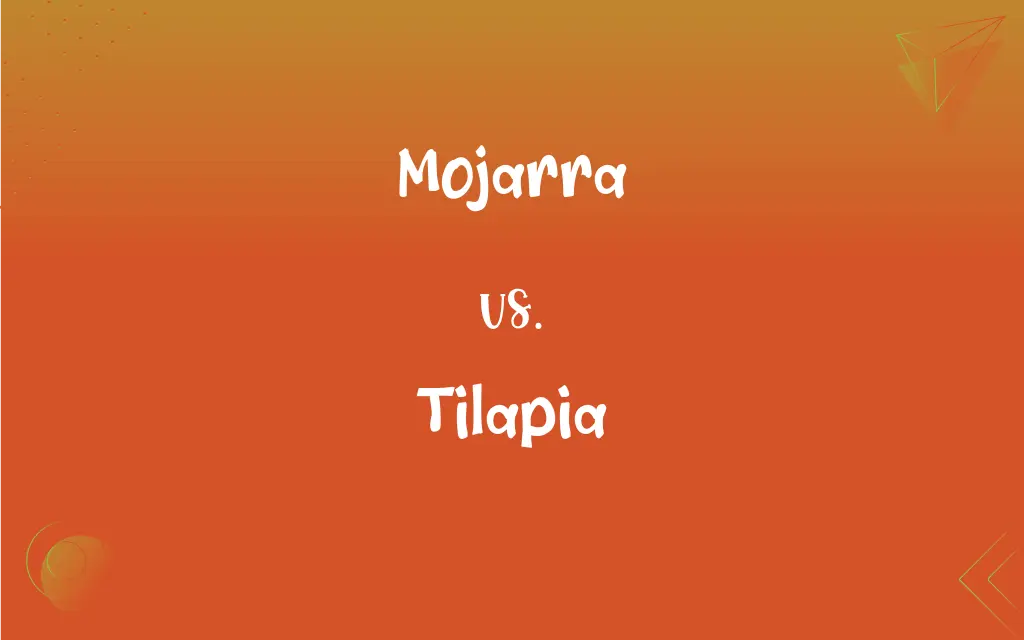Mojarra vs. Tilapia: What's the Difference?
Edited by Aimie Carlson || By Janet White || Updated on March 3, 2024
Mojarra refers to various species of small, tropical fish often found in shallow waters, prized for their taste, while tilapia is a common name for several cichlid species known for their importance in aquaculture and as a food source worldwide.

Key Differences
Mojarras are a diverse group of fish belonging to several genera, commonly found in fresh and brackish waters of tropical and subtropical regions. They are known for their laterally compressed bodies and small to medium size, making them popular among recreational fishers and in some local cuisines. In contrast, tilapia encompasses a broader group of cichlid fish that are significant in global aquaculture due to their fast growth, tolerance to various environmental conditions, and mild flavor, making them a staple protein source in many diets.
While mojarras are often appreciated for their delicate flavor in regional dishes, especially in Latin American and Caribbean cuisines, tilapias are widely cultivated and consumed around the world, featured in a variety of culinary preparations from grilling to baking. Mojarras, due to their smaller size and habitat, are less commonly farmed on a large scale compared to tilapia, which are among the most farmed fish globally due to their resilience and adaptability to different farming methods.
In ecological terms, mojarras play a role in their local ecosystems, often serving as both predators and prey within their food webs. Tilapia, on the other hand, have been introduced to various environments outside their native range, sometimes leading to ecological challenges due to their competitive nature and ability to alter habitats. This has made tilapia a subject of concern in some non-native waters, where they can outcompete local species.
From a nutritional standpoint, both mojarras and tilapias offer valuable sources of protein and other nutrients, though the specific nutritional content can vary based on their diet and environment. However, tilapia's widespread availability and farming have made it more accessible and commonly consumed, contributing significantly to global food security.
Comparison Chart
Taxonomic Grouping
Various genera within the families Gerreidae and others
Mostly from the cichlid family, specifically Oreochromis, Sarotherodon, and Tilapia genera
ADVERTISEMENT
Size and Appearance
Small to medium-sized, laterally compressed bodies
Larger, varied sizes with laterally compressed to deep bodies
Habitat
Primarily tropical and subtropical fresh and brackish waters
Wide range including fresh, brackish, and saltwater environments
Culinary Popularity
Popular in regional cuisines, especially in Latin America and the Caribbean
Globally farmed and consumed, versatile in culinary applications
Aquaculture Presence
Less commonly farmed, more often caught wild
Among the most farmed fish species worldwide due to ease of farming
Ecological Impact
Integral part of local ecosystems, less invasive
Can be invasive outside native range, impacting local biodiversity
ADVERTISEMENT
Nutritional Value
Good source of protein, nutritional value varies by species
High protein content, widely regarded as a healthy food choice
Mojarra and Tilapia Definitions
Mojarra
A term for various small, tropical fish species, valued for their taste.
The fisherman caught a mojarra, perfect for tonight's dinner.
Tilapia
Known for their fast growth and adaptability to various environments.
Tilapia can thrive in different water conditions, making them ideal for farming.
Mojarra
Popular in recreational fishing due to their fighting spirit.
Anglers enjoy catching mojarra for the challenge they present.
Tilapia
Can become invasive when introduced to non-native ecosystems.
In some regions, introduced tilapia have disrupted local aquatic ecosystems.
Mojarra
Often found in shallow coastal and estuarine waters.
Mojarras thrive in the brackish waters of the mangroves.
Tilapia
A significant source of protein in global diets.
Due to its nutritional value and farming efficiency, tilapia is a staple in many diets.
Mojarra
Less common in aquaculture compared to other fish species.
While not typically farmed, mojarra can be found in small-scale aquaculture setups.
Tilapia
A common name for several species of cichlid fish, important in aquaculture.
Tilapia is one of the most consumed farmed fish in the world.
Mojarra
Featured in traditional dishes in their native regions.
Fried mojarra is a delicacy along the Caribbean coast.
Tilapia
Widely cultivated for their mild-flavored, nutritious meat.
Grilled tilapia is a popular dish in many cultures.
Mojarra
Any of various small, silvery, mainly tropical marine fishes of the family Gerreidae, having a very protrusible mouth.
Tilapia
Any of various cichlid fishes of the genera Tilapia, Oreochromis, and Sarotherodon, native to Africa and the Middle East and raised for food in many parts of the world.
Mojarra
Any perciform fish in the family Gerreidae, often used as bait.
Tilapia
Any of various edible fish, formerly species of the genus Tilapia, but now placed in other cichlid genera (such as Oreochromis), native to Africa and the Middle East but cultivated worldwide.
Mojarra
Any of certain basslike marine fishes (mostly of tropical seas, and having a deep, compressed body, protracile mouth, and large silvery scales) constituting the family Gerridæ, as Gerres plumieri, found from Florida to Brazil and used as food. Also, any of numerous other fishes of similar appearance but belonging to other families.
Tilapia
A genus of Cichlidae
Mojarra
Small silvery schooling fishes with protrusible mouths found in warm coastal waters
FAQs
Can mojarra and tilapia be found in the same habitats?
While there may be some overlap in freshwater and brackish environments, mojarras are generally found in more specific tropical and subtropical waters, whereas tilapias are more adaptable to various environments.
How do the flavors of mojarra and tilapia compare?
Both are known for their mild flavor, though mojarra might have a slightly more distinct taste due to its wild-caught nature and diverse species, while tilapia's flavor can be influenced by its farming conditions.
What are the main differences between mojarra and tilapia?
The main differences lie in their taxonomic classification, size, preferred habitats, culinary popularity, presence in aquaculture, and ecological impact.
Are mojarra and tilapia considered sustainable seafood options?
Sustainability can vary widely depending on the source; tilapia farmed in well-managed systems can be sustainable, while the sustainability of wild-caught mojarra depends on local fishing practices.
Why is tilapia more commonly farmed than mojarra?
Tilapia is more commonly farmed due to its rapid growth, adaptability to different farming conditions, and high demand in global markets.
What are the ecological concerns associated with tilapia farming?
Ecological concerns include potential invasiveness when escaped into non-native waters, competition with local species, and habitat alteration.
How do mojarra and tilapia contribute to food security?
Tilapia significantly contributes to global food security through aquaculture, while mojarra, primarily caught in the wild, adds to the dietary diversity in certain regions.
Are there any health concerns associated with consuming tilapia?
As with any farmed fish, health concerns can arise from the methods used in aquaculture, such as the use of antibiotics or feed quality, making it important to source tilapia from reputable farms.
How do the reproductive habits of mojarra and tilapia affect their populations?
Tilapia are known for their prolific breeding, which can lead to overpopulation in farm settings and in non-native environments. Mojarra's reproductive habits vary among species, but generally, they do not reproduce as rapidly or abundantly as tilapia.
Can mojarras be used in the same recipes as tilapias?
Yes, due to their mild flavors, mojarras can be used in similar recipes as tilapias, though their smaller size might require slight adjustments in preparation.
What nutritional benefits do mojarra and tilapia offer?
Both offer high-quality protein, essential vitamins, and minerals, though the specific nutritional profile can vary depending on their diet and environment.
What types of environments are most suitable for mojarra and tilapia farming?
Tilapia thrive in a variety of environments including ponds, cages, and raceways, due to their adaptability. Mojarra, being less commonly farmed, generally require environments that mimic their natural tropical or subtropical habitats.
What role do mojarra and tilapia play in their respective ecosystems?
In their native ecosystems, both mojarra and tilapia can play roles as both predator and prey, contributing to the aquatic food web. Their specific roles can vary based on their size, habitat, and diet.
How do market demands influence the farming and consumption of tilapia compared to mojarra?
Market demands greatly influence the farming of tilapia, with its mild taste and versatility making it a popular choice globally, leading to large-scale aquaculture operations. Mojarra, being less known in the global market, is more often consumed locally and not farmed on the same scale.
What are the key considerations in cooking mojarra vs. tilapia?
Both can be cooked in similar ways due to their mild flavor, but the smaller size of mojarra might lend itself better to frying or pan-searing whole, while tilapia's larger fillets are versatile for grilling, baking, or frying.
What are the challenges of tilapia farming in terms of disease management?
Tilapia farming faces challenges such as managing diseases that can spread quickly in high-density farming operations, requiring careful monitoring and management practices to ensure fish health.
Can mojarra and tilapia be part of a healthy diet?
Yes, both mojarra and tilapia can be part of a healthy diet, offering lean protein and various nutrients. However, it's important to consider the source and preparation methods to maximize health benefits.
How does the introduction of tilapia into non-native waters impact biodiversity?
The introduction of tilapia can lead to competition for food and habitat resources with native species, potentially leading to declines in native biodiversity and altering ecosystem dynamics.
Are there specific conservation efforts aimed at protecting mojarra species?
Conservation efforts for mojarra species typically focus on habitat protection and sustainable fishing practices, particularly in regions where they are a significant part of the local diet and culture.
How does climate change potentially impact mojarra and tilapia populations?
Climate change can impact water temperatures and quality, affecting the habitats and breeding patterns of both mojarra and tilapia, potentially leading to shifts in their populations and distribution.
About Author
Written by
Janet WhiteJanet White has been an esteemed writer and blogger for Difference Wiki. Holding a Master's degree in Science and Medical Journalism from the prestigious Boston University, she has consistently demonstrated her expertise and passion for her field. When she's not immersed in her work, Janet relishes her time exercising, delving into a good book, and cherishing moments with friends and family.
Edited by
Aimie CarlsonAimie Carlson, holding a master's degree in English literature, is a fervent English language enthusiast. She lends her writing talents to Difference Wiki, a prominent website that specializes in comparisons, offering readers insightful analyses that both captivate and inform.































































